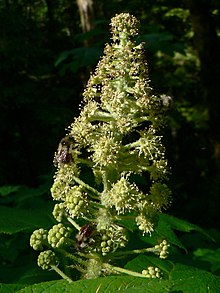Igelkraftwurz
| Igelkraftwurz | ||||||||||||
|---|---|---|---|---|---|---|---|---|---|---|---|---|

Igelkraftwurz ( Oplopanax horridus ) |
||||||||||||
| Systematics | ||||||||||||
|
||||||||||||
| Scientific name | ||||||||||||
| Oplopanax horridus | ||||||||||||
| ( Sm. ) Miq. |
The devil's club ( Oplopanax horridus ) is a plant from the genus Oplopanax in the family of Araliaceae (Araliaceae). It is native to northwest North America .
description
Appearance and foliage leaf
The Igelkraftwurz grows as a deciduous shrub that can reach heights of 1 to 3 meters. The branches, leaf and inflorescence axes are densely covered with up to 1 centimeter long spines.
The alternate leaves arranged on the branches have a strong, up to 30 centimeter long petiole. The simple, paper-like, up to 35 centimeters long and 40 centimeters wide leaf blade is deeply heart-shaped and five- or seven-lobed at the base of the blade. The leaf lobes have a pointed upper end. The leaf margin is serrated with irregular pointed teeth. There are seven raised main nerves on the hand-nerved leaf blade, which are provided with spines.
Inflorescence and flower
The terminal, traubige total inflorescence is slightly shorter than the leaves and is composed of several compact, doldigen part inflorescences, and containing each 10 to 30 flowers of which are long lowest up to 5 centimeters. Each partial inflorescence stands over a paper-like, elongated, frayed bract with a length of about 1 centimeter . The short, shaggy, hairy flower stalk elongates until the fruit is ripe.
The hermaphrodite flowers are five-fold with a double flower envelope . The five approximately 2 millimeter long sepals stand together to form a calyx with a diameter of 1.5 millimeters at the anthesis. The petals 2 to 3 millimeters long and 1 to 1.5 millimeters wide are almost membranous and have a pointed end. There is a fleshy, flattened discus. There is a circle with five stamens . The thin, about 4 millimeters long stamens narrow at their base. The broad-spherical anthers have a diameter of about 1 millimeter. The slightly fleshy, up to 1 to 3 mm long stylus already consists of two stylus branches at its base that end at a point.
fruit
The bare fruit stalk is up to 8 millimeters long. The berry-like stone fruits are initially spherical with a diameter of about 7 millimeters, later a little flattened. The style remains on the fruit for a long time. The seeds are elongated.
Chromosome number
The number of chromosomes is 2n = 48.
Occurrence
The natural range of Igelkraftwurz lies in the northwest of North America. It stretches from southern Alaska and Winnipeg in the north to Oregon , Idaho and Montana and Ontario in the south. There is also a deposit on the Isle Royale in Michigan .
The Igelkraftwurz thrives mostly in damp forests where it is mainly found near bodies of water. It occurs on moist soils .
Systematics
The first description as Panax horridus was in 1813 by James Edward Smith in The Cyclopaedia; or, universial dictionary of arts, ... , 26, p. 10. Friedrich Anton Wilhelm Miquel transferred it to the genus Oplopanax in 1863 in Annales Museum Botanicum Lugduno-Batavi , 1, p. 16 . Some synonyms for Oplopanax horridus (Sm.) Miq. are among others Echinopanax horridum (Sm.) Decne. & Planch. ex Harms , Fatsia horrida (Sm.) Benth. & Hook. f. , Horsfieldia horrida (Sm.) Seem. and Ricinophyllum horridum (Sm.) A. Nelson & JFMacbr.
use
The Igelkraftwurz was often used in the medicine of the Indians, mainly because of its pain-relieving effect. The root bark and the stems have an analgesic, anti-rheumatic, anti-inflammatory, appetite-stimulating, blood-sugar-lowering, blood-cleaning, menstruation-promoting and lactation-promoting and strengthening effect. They are mainly used against colds, bronchitis , tuberculosis and stomach problems. A decoction was taken from the roots against rheumatism and the affected parts of the body were rubbed. The decoction was also used as an eye wash against cataracts . Bark compresses were used for pain relief. An extract can be obtained from the root bark that lowers blood sugar . In higher doses, the inner bark leads to vomiting and has a laxative effect. The burned stems were mixed with oil and used as an ointment for swelling. The fruits were crushed and smeared into the hair to fight dandruff and head lice.
The young above-ground parts of the plant are edible just like the underground parts, but must be peeled and boiled.
Furthermore, the Igelkraftwurz is occasionally used as an ornamental plant .
swell
- Albert Charles Smith: Oplopanax horridus . In: The New York Botanical Garden (Ed.): North American Flora . Volume 28B, No. 1 , 1944, pp. 11 (English, online [accessed June 14, 2011]).
Individual evidence
- ↑ a b c d e Albert Charles Smith: Oplopanax horridus . In: The New York Botanical Garden (Ed.): North American Flora . Volume 28B, No. 1 , 1944, pp. 11 (English, biodiversitylibrary.org - scanned at).
- ^ Oplopanax horridus at Tropicos.org. In: IPCN Chromosome Reports . Missouri Botanical Garden, St. Louis
- ↑ Rafaël Govaerts (Ed.): Oplopanax - World Checklist of Selected Plant Families of the Royal Botanic Gardens, Kew. Last accessed on April 30, 2018.
- ↑ a b c d Oplopanax horridus. In: Plants For A Future. www.pfaf.org, accessed on July 13, 2011 (English).
- ↑ a b Oplopanax horridus at Tropicos.org. Missouri Botanical Garden, St. Louis, accessed July 13, 2011.


